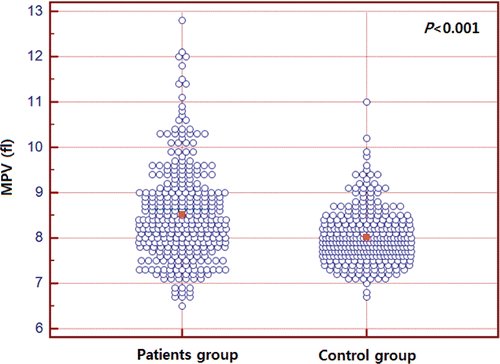To the Editor,
Procalcitonin (PCT) is the precursor of hormone calcitonin, which plays a metabolic role in calcium homeostasis Citation[1]. Every tissue of human body has the potential to produce PCT, and serum level of PCT is usually markedly increased in conditions such as sepsis, systemic infection and severe inflammation Citation[1], Citation[2]. Mean platelet volume (MPV) is known to be associated with platelet reactivity and function Citation[3–6]. MPV has also been investigated in several infectious diseases such as HIV, malaria and hepatitis B. However, it was not fully investigated in systemic bacterial infections. Therefore, we planned to evaluate MPV in patients with significantly increased PCT.
The study group included 322 specimens from 268 Korean patients in which PCT levels were above 1.0 ng/ml (reference limit <0.046 ng/ml) from the Kyung Hee University Hospital, a tertiary teaching hospital, between August and December 2011. To include patients with definitive infection, we enrolled patients to show increased PCT level above 20 folds of the upper reference limit. For the control group, 311 subjects for medical check-ups were enrolled from the same hospital, who were also used as a control group in our previous studies Citation[3], Citation[4]. The mean age of patient group was 64.77 (range 0–94 years), and male-to-female ratio was 188:134. The spectrum of underlying diseases was broad, from malignancy to benign inflammation. Blood sampling was performed through venepuncture and MPV was measured using Ethylenediaminetetraacetic acid (EDTA)-containing tubes in Advia 2120 (Siemens Healthcare Diagnostics Inc., Tarrytown, NY, USA) within 2 hours. Serum PCT was measured using Elecsys BRAHMS PCT (Roche, Mannheim, Germany). Statistical significance was analyzed using the independent sample Student's t-test, and p values <0.05 were considered statistically significant. These statistical analyses were performed with MedCalc v11.6 (MedCalc Software, Mariakerke, Belgium) and Excel 2007 (Microsoft Corporation, Redmond, WA, USA).
In the patient group, means for serum PCT was 9.58 ng/ml (range 1.0–100.0 ng/ml) and for serum CRP was 8.21 mg/dl (range <0.3–28.70 mg/dl), respectively (). The mean MPV level was significantly higher in the patient group, which was 8.51 fl (95% confidence interval: 8.39–8.62 fl, p < 0.001, ). Correlation between MPV and PCT did not show statistical significance, but there was a statistically significant positive correlation between MPV and CRP (p = 0.0001).
Figure 1. Mean platelet volume (MPV) in patients with increased procalcitonin level. The mean of MPV was significantly increased in patients with increased procalcitonin level of >1.0 ng/ml (8.50 fl) than control group (8.02 fl).

Table I. Laboratory characteristics associated with infection in 321 specimens accompanying increased serum procalcitonin level.
MPV reflects both pro-inflammatory and thrombotic conditions, where numerous cytokines can be involved Citation[7–9]. Also, bacterial infections are capable of provoking various pro-inflammatory cytokines as well as PCT, and PCT itself increases leukocyte-derived cytokines Citation[1], Citation[7–9]. In this study, MPV was considerably increased in patients with increased PCT. Therefore, an increase in platelet volume is possibly due to cytokine production and bacterial exotoxin release.
However, there are some limitations to this study. First, because the patient group was recruited according to PCT levels, the majority of patients did not have definitive pathogens that were confirmed by culture. Second, the patient group was highly heterogeneous in terms of diagnostic composition. Third, possible compounding factors such as hypertension or smoking were not totally excluded. In future, additional studies are to be conducted to investigate the following subjects: analysis according to different kinds of infectious agents such as viral vs. fungal infection, relationship to the severity and duration of infection, profiling of cytokine acting on platelet size and activity, exclusion of confounding factors such as smoking or obesity and direct effect of PCT on megakaryogenesis.
References
- Becker KL, Snider R, Nylen ES. Procalcitonin in sepsis and systemic inflammation: A harmful biomarker and a therapeutic target. Br J Pharmacol 2010; 159: 253–264
- Gilbert DN. Use of plasma procalcitonin levels as an adjunct to clinical microbiology. J Clin Microbiol 2010; 48: 2325–2329
- Cho SY, Lee A, Lee HJ, Suh JT, Park TS, Mean platelet volume in Korean patients with hepatic diseases. Platelet 2012 (accepted for publication)
- Cho SY, Jeon YL, Lee HJ, Suh JT, Park TS, Mean platelet volume in Korean patients with acute ischemic stroke: A gender difference. Platelet 2012 Mar 2. [Epub ahead of print]
- Cho SY, Suh JS, Cho BS, Lee WI, Lee HJ, Suh JT, Park TS, Mean platelet volume in pediatric chronic kidney diseases. Platelet 2012 (accepted for publication)
- Chu SG, Becker RC, Berger PB, Bhatt DL, Eikelboom JW, Konkle B, Mohler ER, Reilly MP, Berger JS. Mean platelet volume as a predictor of cardiovascular risk: A systematic review and meta-analysis. J Thromb Haemost 2010; 8: 148–156
- Gasparyan AY, Ayvazyan L, Mikhailidis DP, Kitas GD. Mean platelet volume: A link between thrombosis and inflammation?. Curr Pharm Des 2011; 17: 47–58
- Gasparyan AY, Sandoo A, Stavropoulos-Kalinoglou A, Kitas GD. Mean platelet volume in patients with rheumatoid arthritis: The effect of anti-TNF-α therapy. Rheumatol Int 2010; 30: 1125–1129
- Gasparyan AY, Stavropoulos-Kalinoglou A, Toms TE, Douglas KM, Kitas GD. Association of mean platelet volume with hypertension in rheumatoid arthritis. Inflamm Allergy Drug Targets 2010; 9: 45–50